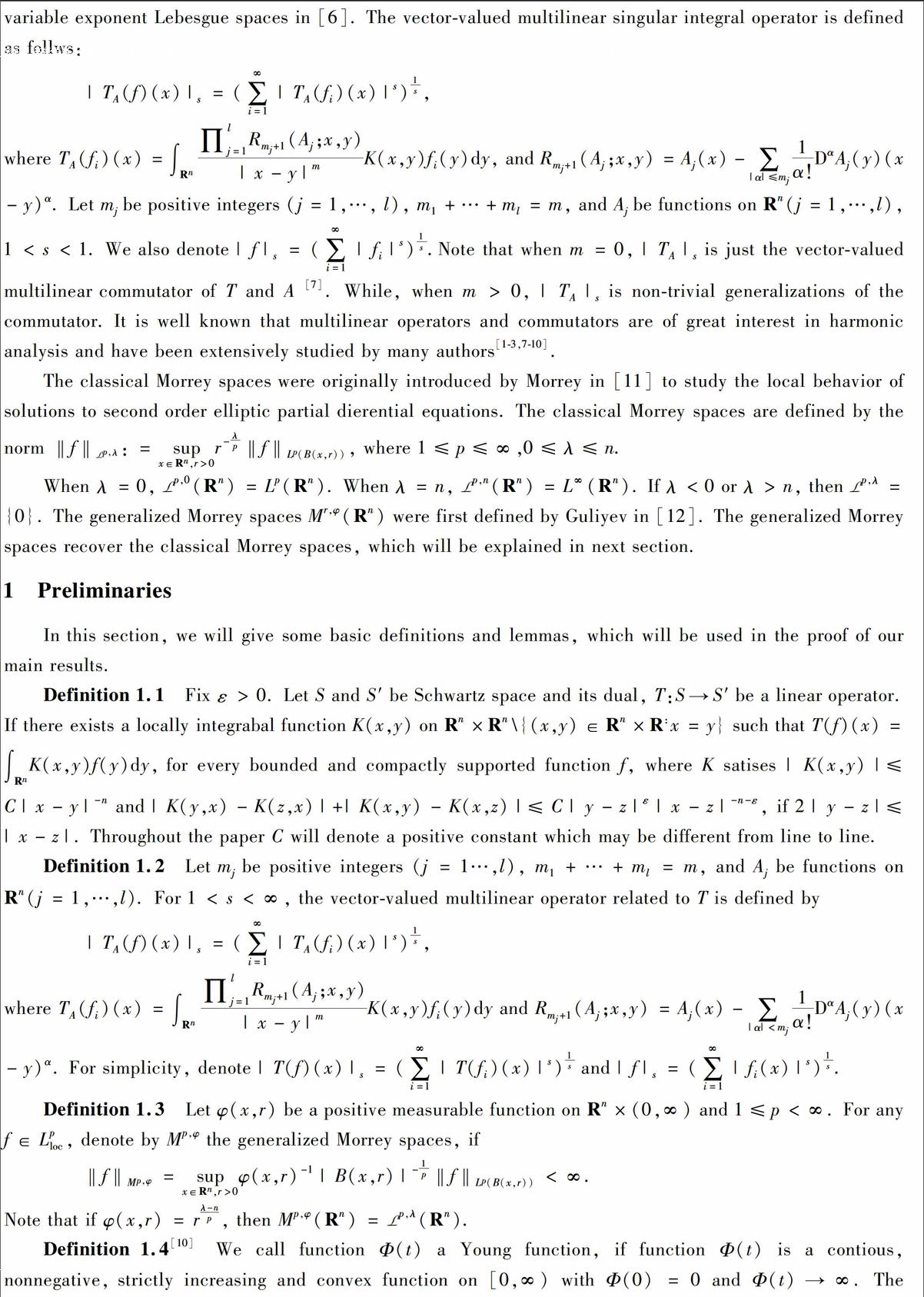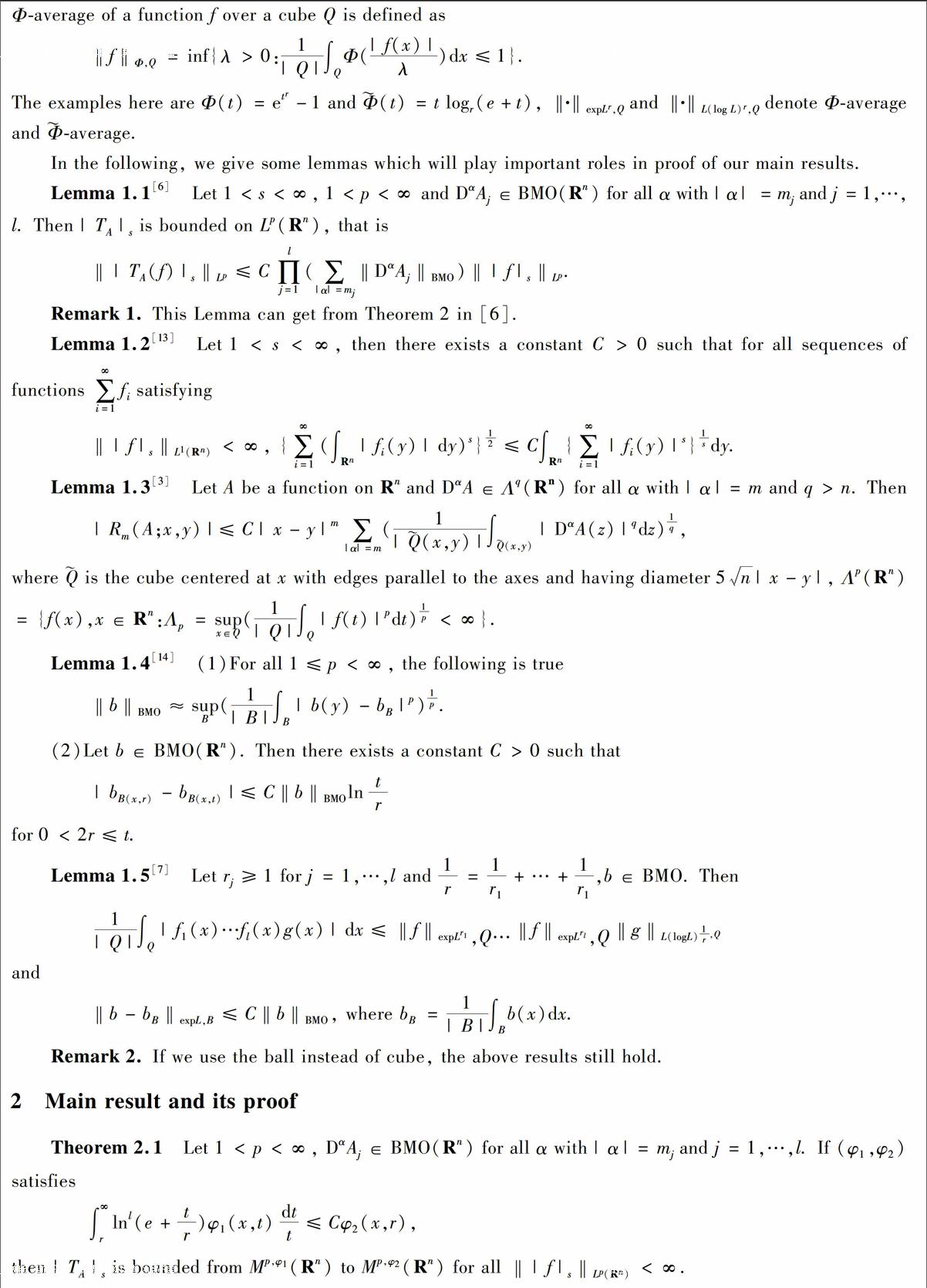向量值多线性奇异积分算子在广义Morrey空间上的有界性(英文)
摘要本文主要讨论向量值多线性奇异积分算子在广义Morrey空间上的有界性.
关键词奇异积分算子;向量值多线性奇异积分算子;有界平均振动空间;广义Morrey空间
The multilinear singular integral operator TA was first introduced by Cohen and Gosselin, which is defined as follows:
TA(f)x=∫RnRm+1(A;x,y)|x-y|mk(x,y)f(y)dy,
where Rm+1(A;x,y)=A(x)-∑|α|≤m1α!DαA(y)(x-y)α, α=(α1,…,αn) denotes a multiindex and |α|=α1+…+αn denotes the order of α. Dα A denote the partial derivative αAα1x1α2x2,…,αnxn,α!=α1!α2!…αn! and (x-y)α=(x1-y1)α1…(xn-yn)αn.
The Lp(p>1) boundedness of the multilinear singular integral operator is proved by the authors of [13]. Later, Hu and Yang proved a variant sharp estimate for the multilinear singular integral operators in [4]. In 2010, Liu considered the multilinear singular integral operators on classical morrey space in [5]. Recently, Du and Huang studied the boundedness of vectorvalued multilinear singular integral operator on variable exponent Lebesgue spaces in [6]. The vectorvalued multilinear singular integral operator is defined as follws:
|TA(f)(x)|s=(∑∞i=1|TA(fi)(x)|s)1s,
where TA(fi)(x)=∫Rn∏lj=1Rmj+1(Aj;x,y)|x-y|mK(x,y)fi(y)dy, and Rmj+1(Aj;x,y)=Aj(x)-∑|α|≤mj1α!DαAj(y)(x-y)α. Let mj be positive integers (j=1,…, l), m1+…+ml=m, and Aj be functions on Rn (j=1,…,l),1
The classical Morrey spaces were originally introduced by Morrey in [11] to study the local behavior of solutions to second order elliptic partial dierential equations. The classical Morrey spaces are defined by the norm ‖f‖Lp,λ:=supx∈Rn,r>0r-λp‖f‖Lp(B(x,r)), where 1≤p≤∞,0≤λ≤n.
When λ=0, Lp,0(Rn)=Lp(Rn). When λ=n, Lp,n(Rn)=L∞(Rn). If λ<0 or λ>n, then Lp,λ={0}. The generalized Morrey spaces Mr,φ(Rn) were first defined by Guliyev in [12]. The generalized Morrey spaces recover the classical Morrey spaces, which will be explained in next section.
湖南师范大学自然科学学报第38卷第5期俞飞:向量值多线性奇异积分算子在广义Morrey空间上的有界性1Preliminaries
In this section, we will give some basic definitions and lemmas, which will be used in the proof of our main results.
Definition 1.1Fix ε>0. Let S and S′ be Schwartz space and its dual, T:S→S′ be a linear operator. If there exists a locally integrabal function K(x,y) on Rn×Rn\{(x,y)∈Rn×R:x=y} such that T(f)(x)=∫RnK(x,y)f(y)dy, for every bounded and compactly supported function f, where K satises |K(x,y)|≤C|x-y|-n and |K(y,x)-K(z,x)|+|K(x,y)-K(x,z)|≤C|y-z|ε|x-z|-n-ε, if 2|y-z|≤|x-z|. Throughout the paper C will denote a positive constant which may be different from line to line.
Definition 1.2Let mj be positive integers (j=1…,l), m1+…+ml=m, and Aj be functions on Rn (j=1,…,l). For 1 |TA(f)(x)|s=(∑∞i=1|TA(fi)(x)|s)1s, where TA(fi)(x)=∫Rn∏lj=1Rmj+1(Aj;x,y)|x-y|mK(x,y)fi(y)dy and Rmj+1(Aj;x,y)=Aj(x)-∑|α| Definition 1.3Let φ(x,r) be a positive measurable function on Rn×(0,∞) and 1≤p<∞. For any f∈Lploc, denote by Mp,φ the generalized Morrey spaces, if ‖f‖Mp,φ=supx∈Rn,r>0φ(x,r)-1|B(x,r)|-1p‖f‖Lp(B(x,r))<∞. Note that if φ(x,r)=rλ-np, then Mp,φ(Rn)=Lp,λ(Rn). Definition 1.4[10]We call function Φ(t) a Young function, if function Φ(t) is a contious, nonnegative, strictly increasing and convex function on [0,∞) with Φ(0)=0 and Φ(t)→∞. The Φaverage of a function f over a cube Q is defined as ‖f‖Φ,Q=inf{λ>0:1|Q|∫QΦ(|f(x)|λ)dx≤1}. The examples here are Φ(t)=etr-1 and (t)=t logr(e+t), ‖·‖expLr,Q and ‖·‖L(log L)r,Q denote Φaverage and average. In the following, we give some lemmas which will play important roles in proof of our main results. Lemma 1.1[6]Let 1 ‖|TA(f)|s‖Lp≤C∏lj=1(∑|α|=mj‖DαAj‖BMO)‖|f|s‖Lp. Remark 1. This Lemma can get from Theorem 2 in [6]. Lemma 1.2[13]Let 1 ‖|f|s‖L1(Rn)<∞, {∑∞i=1(∫Rn|fi(y)|dy)s}12≤C∫Rn{∑∞i=1|fi(y)|s}1sdy. Lemma 1.3[3]Let A be a function on Rn and DαA∈Λq(Rn) for all α with |α|=m and q>n. Then |Rm(A;x,y)|≤C|x-y|m∑|α|=m(1|(x,y)|∫(x,y)|DαA(z)|qdz)1q, where is the cube centered at x with edges parallel to the axes and having diameter 5n|x-y|, Λp(Rn)={f(x),x∈Rn:Λp=supx∈Q(1|Q|∫Q|f(t)|pdt)1p<∞}. Lemma 1.4[14](1)For all 1≤p<∞, the following is true ‖b‖BMO≈supB(1|B|∫B|b(y)-bB|p)1p. (2)Let b∈BMO(Rn). Then there exists a constant C>0 such that |bB(x,r)-bB(x,t)|≤C‖b‖BMOlntr for 0<2r≤t. Lemma 1.5[7]Let rj≥1 for j=1,…,l and 1r=1r1+…+1r1,b∈BMO. Then 1|Q|∫Q|f1(x)…fl(x)g(x)|dx≤‖f‖expLr1,Q…‖f‖expLrl,Q‖g‖L(logL)1r,Q and ‖b-bB‖expL,B≤C‖b‖BMO, where bB=1|B|∫Bb(x)dx. Remark 2. If we use the ball instead of cube, the above results still hold. 2Main result and its proof
Theorem 2.1Let 1 ∫∞rlnl(e+tr)φ1(x,t)dtt≤Cφ2(x,r), then |TA|s is bounded from Mp,φ1(Rn) to Mp,φ2(Rn) for all ‖|f|s‖Lp(Rn)<∞. ProofSet B=(x0,r), 2B=B(x0,2r). Without loss of generality, we may assume l=2. Let j(x)=Aj(x)-∑|α|=mj1α!(DαAj)Bxα, then Rmj+1(Aj;x,y)=Rmj+1(j;x,y) and Dαj=DαAj-(DαAj)B for |α|=mj. We split f into two parts, f=g+h={gi}+{hi}={fiχ2B}+{fiχRn\2B}. ‖(∑∞i=1|TA(fi)(x)|s)1s‖Lp(B)≤‖(∑∞i=1|TA(gi)(x)|s)1s‖Lp(B)+‖(∑∞i=1|TA(hi)(x)|s)1s‖Lp(B):=I+II. For I, by Lemma 2.1 then we have I≤‖(∑∞i=1|TA(gi)(x)|s)1s‖Lp≤C∏lj=1(∑|α|=mj‖DαAj‖BMO)‖|g|s‖Lp= C∏lj=1(∑|α|=mj‖DαAj‖BMO)‖|f|s‖Lp(2B). On the other hand, ‖|f|s‖Lp(2B)≈rnp‖|f|s‖Lp(2B)∫∞2rdttnp+1≤Crnp∫∞2r‖|f|s‖Lp(B(x0,t))t-np-1dt. Then we can get I≤C∏lj=1(∑|α|=mj‖DαAj‖BMO)rnp∫∞2r‖|f|s‖Lp(B(x0,t))t-np-1dt. Now let us estimate II ‖(∑∞i=1|TA(hi)(x)|s)1s‖Lp(B)= ‖(∑∞i=1|∫Rn∏2j=1Rmj+1(j;x,y)|x-y|mK(x,y)hi(y)dy|s)1s‖Lp(B)≤ C‖(∑∞i=1|∫Rn∏2j=1Rmj(j;x,y)|x-y|mK(x,y)hi(y)dy|s)1s‖Lp(B)+ ‖(∑∞i=1|∑||=m11!∫RnRm2(2;x,y)(x-y)|x-y|mD1(y)K(x,y)hi(y)dy|s)1s‖Lp(B)+ ‖(∑∞i=1|∑||=m21!∫RnRm2(1;x,y)(x-y)|x-y|mD2(y)K(x,y)hi(y)dy|s)1s‖Lp(B)+ ‖(∑∞i=1|∑||=m1,||=m21!!∫Rn(x-y)+D1(y)D2(y)|x-y|mK(x,y)hi(y)dy|s)1s‖Lp(B):= I1+I2+I3+I4 We first estimate I1. By Lemma 2.3 and 2.4, we have Rmj(j;x,y)≤C|x-y|mj∑|α|=mj(1|Q(x,y)|∫Q(x,y)|DαAj-(DαAj)B|qdz)1q≤ C|x-y|mj∑|α|=mj(|3nB(x,y)||Q(x,y)|1|3nB(x,y)|∫3nB(x,y)|DαAj-(DαAj)B|qdz)1q≤ C|x-y|mj∑|α|=mj(1|3nB(x,y)|∫3nB(x,y)|DαAj-(DαAj)3nB(x,y)|qdz)1q+ C|x-y|mj∑|α|=mj(1|3nB(x,y)|∫3nB(x,y)|(DαAj)3nB(x,y)-(DαAj)B|qdz)1q≤ C|x-y|mj∑|α|=mj‖DαAj‖BMO+ C|x-y|mj∑|α|=mj‖DαAj‖BMO(1|3nB(x,y)|∫3nB(x,y)|ln(e+3n|x-y|r)|qdz)1q≤ C|x-y|mj∑|α|=mj‖DαAj‖BMOln(e+|x-y|r), where B(x,y) is the ball centered at x and has radius r=|x-y|, 3nB(x,y) denote the ball centered at x and has radius r=3n|x-y|. Notice that x∈B(x0,r),32|y-x0|≥|y-x0|+|x0-x|≥|y-x|≥|y-x0|-|x0-x|≥12|y-x0|. Then by Lemma 2.2,2.3 and 2.4 and Hlder inequality, we have (∑∞i=1|∫Rn∏2j=1Rmj(j;x,y)|x-y|mK(x,y)hi(y)dy|s)1s≤ C∏2j=1(∑|α|=mj‖DαAj‖BMO)(∫Rn{∑∞i=1|ln2(e+|x-y|r)K(x,y)hi(y)s|}1sdy)≤ C∏2j=1(∑|α|=mj‖DαAj‖BMO)(∫|y-x0|>2rln2(e+|x-y|r)|f|s|x-y|-ndy)≤ C∏2j=1(∑|α|=mj‖DαAj‖BMO)(∫|y-x0|>2rln2(e+|x0-y|r)|f|s|x0-y|-ndy)≤ C∏2j=1(∑|α|=mj‖DαAj‖BMO)(∫|y-x0|>2rln2(e+|x0-y|r)|f|s∫+∞|y-x0|dttn+1dy)≤
C∏2j=1(∑|α|=mj‖DαAj‖BMO)(∫+∞2r∫2r<|y-x0| C∏2j=1(∑|α|=mj‖DαAj‖BMO)(∫+∞2rln2(e+tr)∫2r<|y-x0| C∏2j=1(∑|α|=mj‖DαAj‖BMO)(∫+∞2rln2(e+tr)‖|f|s‖Lp(B(x0,t))t-np-1dt). So we get I1≤C∏2j=1(∑|α|=mj‖DαAj‖BMO)rnp∫+∞2rln2(e+tr)‖|f|s‖Lp(B(x0,t))t-np-1dt. Next, we estimate I2. Applying Lemma 2.2, 2.3 and 2.4 and Hlder inequality, note that 32|y-x0|≥|y-x|≥12|y-x0|,then we obtain (∑∞i=1|∑||=m11!∫RnRm2(2;x,y)(x-y)|x-y|mD1(y)K(x,y)hi(y)dy|s)1s≤ C∑||=m2‖DA2‖BMO(∑∞i=1|∑||=m1∫Rnln(e+|x-y|r)D1(y)K(x,y)hi(y)dy|s)1s≤ C∑||=m2‖DA2‖BMO∫Rn{∑∞i=1|∑||=m1ln(e+|x-y|r)D1(y)K(x,y)hi(y)|s}1sdy≤ C∑||=m2‖DA2‖BMO∫|y-x0|>2rln(e+x0-yr)|∑||=m1D1(y)||f|s1|x0-y|ndy≤ C∑||=m2‖DA2‖BMO∫|y-x0|>2rln(e+x0-yr)|∑||=m1D1(y)||f|s∫+∞|y-x0|dttn+1dy≤ C∑||=m2‖DA2‖BMO∫+∞2rln(e+tr)∫2r<|y-x0| C∑||=m2‖DA2‖BMO∫+∞2rln(e+tr)∑||=m1‖D1(y)‖Lp′(B(x0,t))‖|f|s‖Lp(B(x0,t))dttn+1≤ C∑||=m2‖DA2‖BMO∫+∞2rln(e+tr)∑||=m1(1|B(x0,t)|∫B(x0,t)|DA1(y)-(DA1)B|p′)1p′ ‖|f|s‖Lp(B(x0,t))t-np-1dt≤ C∑||=m2‖DA2‖BMO∫+∞2rln(e+tr)∑||=m1(1|B(x0,t)|∫B(x0,t)|DA1(y)-(DA1)B(x0,t)|p′)1p′ ‖|f|s‖Lp(B(x0,t))t-np-1dt≤ C∑||=m2‖DA2‖BMO∫+∞2rln(e+tr)∑||=m1(1|B(x0,t)|∫B(x0,t)|(DA1)B(x0,t)-(DA1)B|p′)1p′ ‖|f|s‖Lp(B(x0,t))t-np-1dt≤ C∏2j=1(∑|α|=mj‖DαAj‖BMO)(∫+∞2rln2(e+tr)‖|f|s‖Lp(B(x0,t))t-np-1dt)+ C∏2j=1(∑|α|=mj‖DαAj‖BMO)(∫+∞2rln2(e+tr)‖|f|s‖Lp(B(x0,t))t-np-1dt)≤ C∏2j=1(∑|α|=mj‖DαAj‖BMO)(∫+∞2rln2(e+tr)‖|f|s‖Lp(B(x0,t))t-np-1dt). Then I2≤C∏2j=1(∑|α|=mj‖DαAj‖BMO)rnp∫+∞2rln2(e+tr)‖|f|s‖Lp(B(x0,t))t-np-1dt. Using the same method in proof of I2, we can get I3≤C∏2j=1(∑|α|=mj‖DαAj‖BMO)rnp∫+∞2rln2(e+tr)‖|f|s‖Lp(B(x0,t))t-np-1dt. Finally we estimate I4, by Lemma 2.2, 2.3 and 2.4 and Hlder inequality, notice that 32|y-x0|≥|x-y|≥12|y-x0|, then we have that (∑∞i=1|∑||=m1,||=m21!!∫Rn(x-y)+D1(y)D2(y)|x-y|mK(x,y)hi(y)dy|s)1s≤ C(∑∞i=1|∑||=m1,||=m2∫Rn|D1(y)D2(y)K(x,y)hi(y)dy|s)1s≤ C∑||=m1,||=m2∫|y-x0|>2r|D1(y)D2(y)|1|y-x0|n|f|sdy≤ C∑||=m1,||=m2∫|y-x0|>2r|D1(y)D2(y)||f|s∫+∞|y-x0|dttn+1dy≤ C∑||=m1,||=m2∫+∞2r∫2r<|y-x0| C∑||=m1,||=m2∫+∞2r∫2r<|y-x0| C∑||=m1,||=m2∫+∞2r∫2r<|y-x0| (DA2(y)-(DA2)B)|p′dy)1p′‖|f|s‖Lp(B(x0,t))t-np-1dt≤ C∑||=m1,||=m2∫+∞2r∫2r<|y-x0|
[DA2(y)-(DA2)B(x0,t)]|p′dy)1p′‖|f|s‖Lp(B(x0,t))t-np-1dt+
C∑||=m1,||=m2∫+∞2r∫2r<|y-x0| [(DA2)Bx0,t-(DA2)B]|p′dy)1p′‖|f|s‖Lp(B(x0,t))t-np-1dt+ C∑||=m1,||=m2∫+∞2r∫2r<|y-x0| [DA2(y)-(DA2)B(x0,t)]|p′dy)1p′‖|f|s‖Lp(B(x0,t))t-np-1dt+ C∑||=m1,||=m2∫+∞2r∫2r<|y-x0| [(DA2)B(x0,t)-(DA2)B]|p′dy)1p′‖|f|s‖Lp(B(x0,t))t-np-1dt:=I14+I24+I34+I44. For I14, by Lemma 2.5 we have I14≤C∫+∞2r∑||=m1(‖[DA1(y)-(DA1)B(x0,t)]p′‖expL1p′,B(x0,t))1p′‖|f|s‖Lp(B(x0,t))t-np-1 (‖1‖L(log L)12p′,B(x0,t))1p′∑||=m2(‖[DA2(y)-(DA2)B(x0,t)]p′‖expL1p′,B(x0,t))1p′dt≤ C∫+∞2r∑||=m1‖[DA1(y)-(DA1)B(x0,t)]‖expL,B(x0,t)‖|f|s‖Lp(B(x0,t)) ∑||=m2‖[DA2(y)-(DA2)B(x0,t)]‖expL,B(x0,t)t-np-1dt≤ C∏2j=1(∑|α|=mj‖DαAj‖BMO)∫+∞2r‖|f|s‖Lp(B(x0,t))t-np-1dt. The estimate of I24 is as follows I24≤C∑||=m2‖DA2‖BMO∑||=m1∫+∞2rln(e+tr)(1|B(x0,t)|∫B(x0,t)|DA1(y)-(DA1)B(x0,t)|p′dy)1p′ ‖|f|s‖Lp(B(x0,t))t-np-1dt≤ C∏2j=1(∑|α|=mj‖DαAj‖BMO)∫+∞2rln(e+tr)‖|f|s‖Lp(B(x0,t))t-np-1dt. The estimate of I34 is the same as above. I34≤C∏2j=1(∑|α|=mj‖DαAj‖BMO)∫+∞2rln(e+tr)‖|f|s‖Lp(B(x0,t))t-np-1dt. Now we estimate I44. I44≤C∏2j=1(∑|α|=mj‖DαAj‖BMO)∫+∞2rln2(e+tr)‖|f|s‖Lp(B(x0,t))t-np-1dt. According to the above estimate, we obtain I4≤C∏2j=1(∑|α|=mj‖DαAj‖BMO)rnp∫+∞2rln2(e+tr)‖|f|s‖Lp(B(x0,t))t-np-1dt. Thus, ‖(∑∞i=1|TA(fi)(x)|s)1s‖Lp(B)≤C∏lj=1(∑|α|=mj‖DαAj‖BMO)rnp∫+∞2rlnl(e+tr)‖|f|s‖Lp(B(x0,t))t-np-1dt. Then according to the condition, ‖|TA|s‖Mp,φ2=supx0∈Rn,r>0φ2(x,r)-1|B(x,r)|-np‖|TA|s‖Lp(B(x0,r))≤ C∏lj=1(∑|α|=mj‖DαAj‖BMO)supx0∈Rn,r>01φ2(x0,r)∫+∞rlnl(e+tr)‖|f|s‖Lp(B(x0,t))dt≤ C∏lj=1(∑|α|=mj‖DαAj‖BMO)‖|f|s‖Mp,φ1supx0∈Rn,r>01φ2(x0,r)∫+∞rlnl(e+tr)φ1(x0,t)dtt≤ C∏lj=1(∑|α|=mj‖DαAj‖BMO)‖|f|s‖Mp,φ1. The proof is completed. References: [1]COHEN J. A sharp estimate for a multilinear singular integral in Rn[J]. Indiana Univ Math J, 1981,30(5):693702. [2]COHEN J, GOSSELIN J. On multilinear singular integrals on Rn[J]. Studia Math, 1982,72(4):199223. [3]COHEN J, GOSSELIN J. A BMO estimate for multilinear singular integrals[J]. Illinois J Math, 1986,30(3):445464. [4]HU G, YANG D. A variant sharp estimate for multilinear singular integral operators[J]. Studia Math, 2000,141(1):2225.
[5]LIU L. Boundedness for multilinear singular integral operators on Morrey spaces[J]. Bull Malays Math Sci Soc, 2010,33(1):93103.
[6]DU J, HUANG C, LIU L. Boundedness for vectorvalued multilinear singular integral operator on Lp spaces with variable exponent[J]. Bull Acad Stiinte Repub Mold Math, 2012,3(70):315.
[7]PREZ C, TRUJILLOGONZALEZ R. Sharp weighted estimates for multilinear commutators[J]. Lond Math Soc, 2002,65(03):672692.
[8]PREZ C, PRADOLINI G. Sharp weighted endpoint estimates for commutators of singular integrals[J]. Michigan Math J, 2001,49(1):2337.
[9]PREZ C, TRUJILLOGONZLEZ R. Sharp weighted estimates for vectorvalued singular integral operators and commutators[J]. Tohoku Math J, 2003,55(1):109129.
[10]PEREZ C. Endpoint estimates for commutators of singular integral operators[J]. J Funct Anal, 1995,128(1):163185.
[11]MORREY J R C B. On the solutions of quasilinear elliptic partial dierential equations[J]. Trans Am Math Soc, 1938,38(1):126166.
[12]GULIYEV V S, ALIYEV S S, KARAMAN T. Boundedness of sublinear operators and commutators on generalized Morrey spaces[J]. Integr Equ Oper Theor, 2011,71(3):327355.
[13]KARLOVICH A, LERNER A. Commutators of singular integrals on generalized Lp spaces with variable exponent[J]. Publ Math, 2005,49(1):111125.
[14]GRAFAKOS L. Classical and modern Fourier analysis[M]. New Jersey: Prentice Hall, 2004.
(编辑胡文杰)




